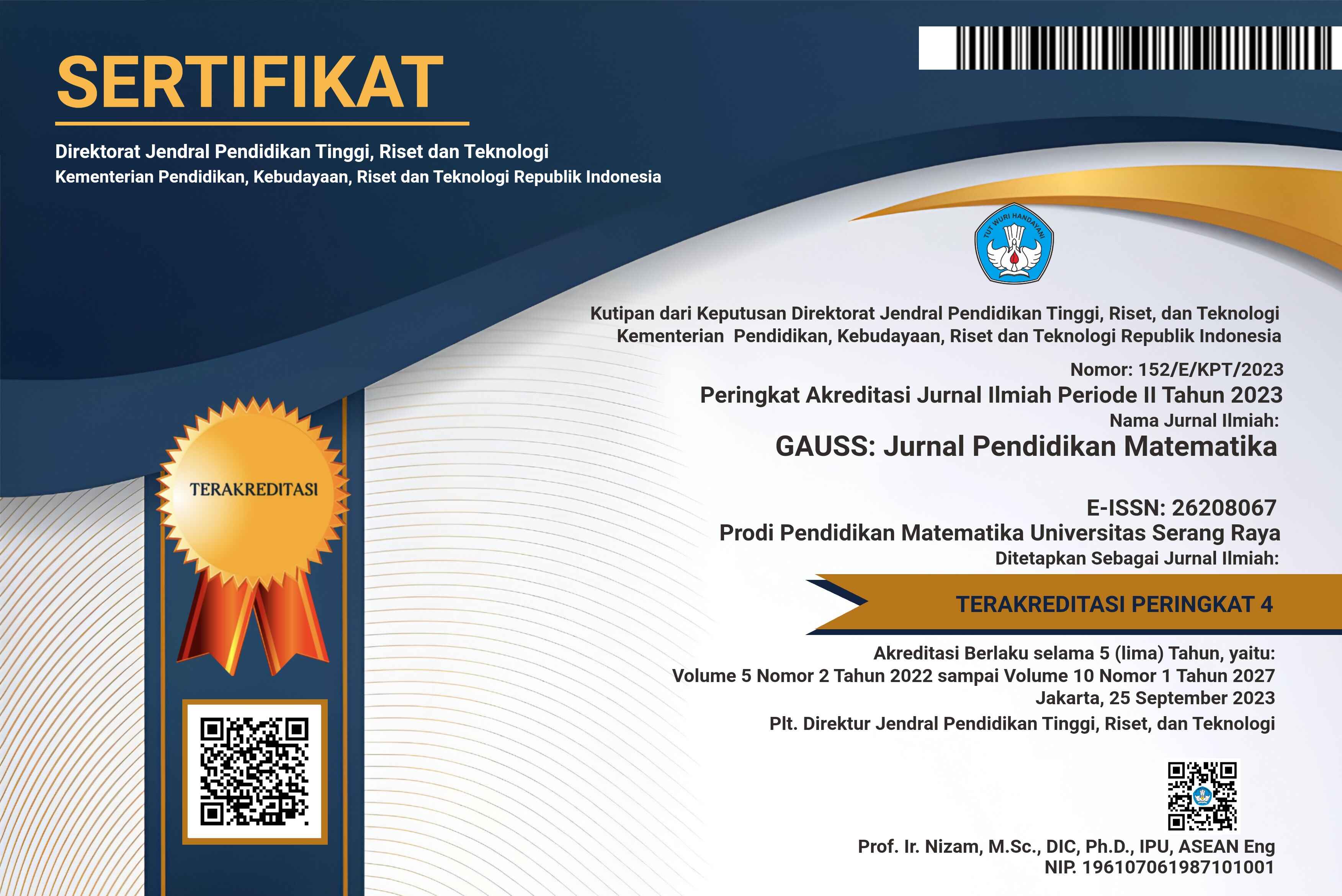Materi Kompetensi Matematika Lulusan SMK dan Kebutuhan Dunia Industri
DOI:
https://doi.org/10.30656/gauss.v2i1.1430Keywords:
Kesenjangan, Konten matematika, SMKAbstract
Penelitian ini bertujuan untuk mendeskripsikan kesenjangan implementasi konten matematika sekolah menengah kejuruan (SMK) yang terjadi antara dunia pendidikan dan dunia industri. Metode pendekatan yang digunakan dalam penelitian ini adalah deskriptif kuantitatif dengan wawancara, observasi dan dokumentasi kepada SMK dan empat industri baja yang beroperasi di Kota Cilegon. Hasil yang didapatkan adalah kemampuan matematika di dunia pendidikan yang meliputi berbagai konten materi yang diajarkan di SMK hanya beberapa digunakan dalam dunia industri. Sedangkan untuk industri baja hanya sebatas pada penggunaan angka dan logika matematika. Hal tersebut dikarenakan pekerjaan level pelaksana masih terbatas pada instruksional dan berdasarkan pada standar prosedur yang sudah ditetapkan oleh superior.Â
Kata Kunci: Kesenjangan, Konten matematika, SMK
References
Agus, A., Awang, A. H., Yussof, I., & Makhbul, Z. K. M. (2011). The Gap Analysis of Graduate Employees Work Skills in Malaysia. In Proceeding Business and Information (pp. 1–15). Bangkok: International Business Academics Consortium Academy of Taiwan Information System Research.
Ahmad, A. W., & Shahrill, M. (2014). Improving Post-Secondary Students ’ Algebraic Skills in the Learning of Complex Numbers. International Journal of Science and Research, 3(8), 273–279.
Apino, E., & Retnawati, H. (2017). Developing Instructional Design to Improve Mathematical Higher Order Thinking Skills of Students. In IOP Conf. Series: Journal of Physics: Conf. Series 812 (Vol. 812, pp. 1–7).
Ayonmike, C. ., & Okeke, B. C. (2016). Bridging The Skills Gap and Tackling Unemployment of Vocational Graduates Through Partnerships in Nigeria. Journal of Technical Education and Training (JTET), 8(2), 1–11.
Calao, L. A., Moreno-Le´on, J., Correa, H. E., & Robles, G. (2015). Developing Mathematical Thinking with Scratch An Experiment with 6th Grade Students. In G. Conole et al. (Eds.): EC-TEL 2015, LNCS 9307 (pp. 17–27). https://doi.org/10.1007/978-3-319-24258-3-2
Chookittikul, W., Kourik, J. L., & Maher, P. E. (2011). Reducing the Gap between Academia and Industry : The Case for Agile Methods in Thailand. In Eighth International Conference on Information Technology: New Generations (pp. 239–244). https://doi.org/10.1109/ITNG.2011.49
DEST. (2006). Food Processing Industry Training Package (Vol. 3). Canberra.
Du Plessisis, A., Frederick, H., & Maritz, A. (2013). Education and training deficits in industrial clusters : Empirical evidence that management can use to rectify the Skills gap in auckland precinct CLUSTERS : EMPIRICAL EVIDENCE THAT MANAGEMENT CAN. Actual Problem of Economics, 2(3), 12–20.
Emzir. (2017). Metodologi Penelitian Pendidikan Kuantitatif dan Kualitatif. Depok: Rajawali Pers.
Fajriyah, L., Nugraha, Y., Akbar, P., & Bernard, M. (2015). Pengaruh Kemandirian Belajar Siswa SMP Terhadap Kemampuan Penalaran Matematis. Journal on Education, 01(02), 288–296.
FitzSimons, G. E. (2002). What Counts as Mathematics? Technologies of Power in Adult and Vocational Education (1st ed.). Netherland: Springer Netherlands.
FitzSimons, G. E. (2014). Commentary on vocational mathematics education: Where mathematics education confronts the realities of people’s work. Educational Studies in Mathematics, 86(2), 291–305. https://doi.org/10.1007/s10649-014-9556-0
Hoyles, C., Wolf, A., Molyneux-Hodgson, S., & Kent, P. (2002). Mathematical skills in the workplace: final report to the Science Technology and Mathematics Council. London. Retrieved from http://eprints.ioe.ac.uk/1565/1/Hoyles2002MathematicalSkills.pdf
Morissan, M. (2014). Metode Penelitian Suvei (2nd ed.). Jakarta: Kencana Prenadamedia.
Mulder, M., Weigel, T., & Collins, K. (2007). The concept of competence in the development of vocational education and training in selected EU member states: A critical analysis. Journal of Vocational Education and Training, 59(1), 67–88. https://doi.org/10.1080/13636820601145630
Nindiasari, H., Kusumah, Y., Sumarmo, U., & Sabandar, J. (2014). Pendekatan Metakognitif untuk Meningkatkan Kemampuan Berpikir Reflektif Matematis Siswa SMA. Edusentris, Jurnal Ilmu Pendidikan Dan Pengajaran, 1(1), 80–90.
Peraturan Direktur Jenderal Pendidikan Dasar dan Menengah Kementerian Pendidikan dan Kebudayaan No. 07/D.D5/KK/2018. (2018), (021), 307.
Peraturan Menteri Pendidikan dan Kebudayaan Republik Indonesia Nomor 20 Tahun 2016 Tentang Standar Kompetensi Lulusan Pendidikan Dasar dan Menengah (2016).
Saragih, S., & Winmery L. Habeahan. (2014). The Improving of Problem Solving Ability and Students ’ Creativity Mathematical by Using Problem Based Learning in SMP Negeri 2 Siantar. Journal of Education and Practice, 5(35), 123–133.
Wake, G. (2014). Making sense of and with mathematics: The interface between academic mathematics and mathematics in practice. Educational Studies in Mathematics, 86(2), 271–290. https://doi.org/10.1007/s10649-014-9540-8
Wake, G., & Yasukawa, K. (2015). Mathematics Education in and for Work. In S. J. Cho (Ed.), The proceedings of the 12th International Congress on Mathematical Education - Intellectual and Attitudinal Challenges (p. 406). Soul: Springer Open.
Williams, J. S., Wake, G. D., & Boreham, N. C. (2001). School or college mathematics and workplace practice: An activity theory perspective. Research in Mathematics Education, 3(1), 69–83. https://doi.org/10.1080/14794800008520085
Zaenab, S. (2015). Analisis Kemampuan Penalaran Matematis Siswa Melalui Pendekatan Problem Posing di Kelas X IPA 1 SMA Negeri 9 Malang. Jurnal Inovasi Pembelajaran, 1(1), 90–97.
Downloads
Published
Issue
Section
License
Authors who publish articles in GAUSS : JURNAL PENDIDIKAN MATEMATIKA agree to the following terms:
- Authors retain copyright and grant the journal the right of first publication with the work simultaneously licensed under a Creative Commons Attribution-ShareAlike 4.0 International License that allows others to share the work with an acknowledgment of the work's authorship and initial publication in this journal.
- Authors are able to enter into separate, additional contractual arrangements for the non-exclusive distribution of the journal's published version of the work (e.g., post it to an institutional repository or publish it in a book), with an acknowledgment of its initial publication in this journal.
- Authors are permitted and encouraged to post their work online (e.g., in institutional repositories or on their website) before and during the submission process, as it can lead to productive exchanges, as well as earlier and greater citation of published work (See The Effect of Open Access).




